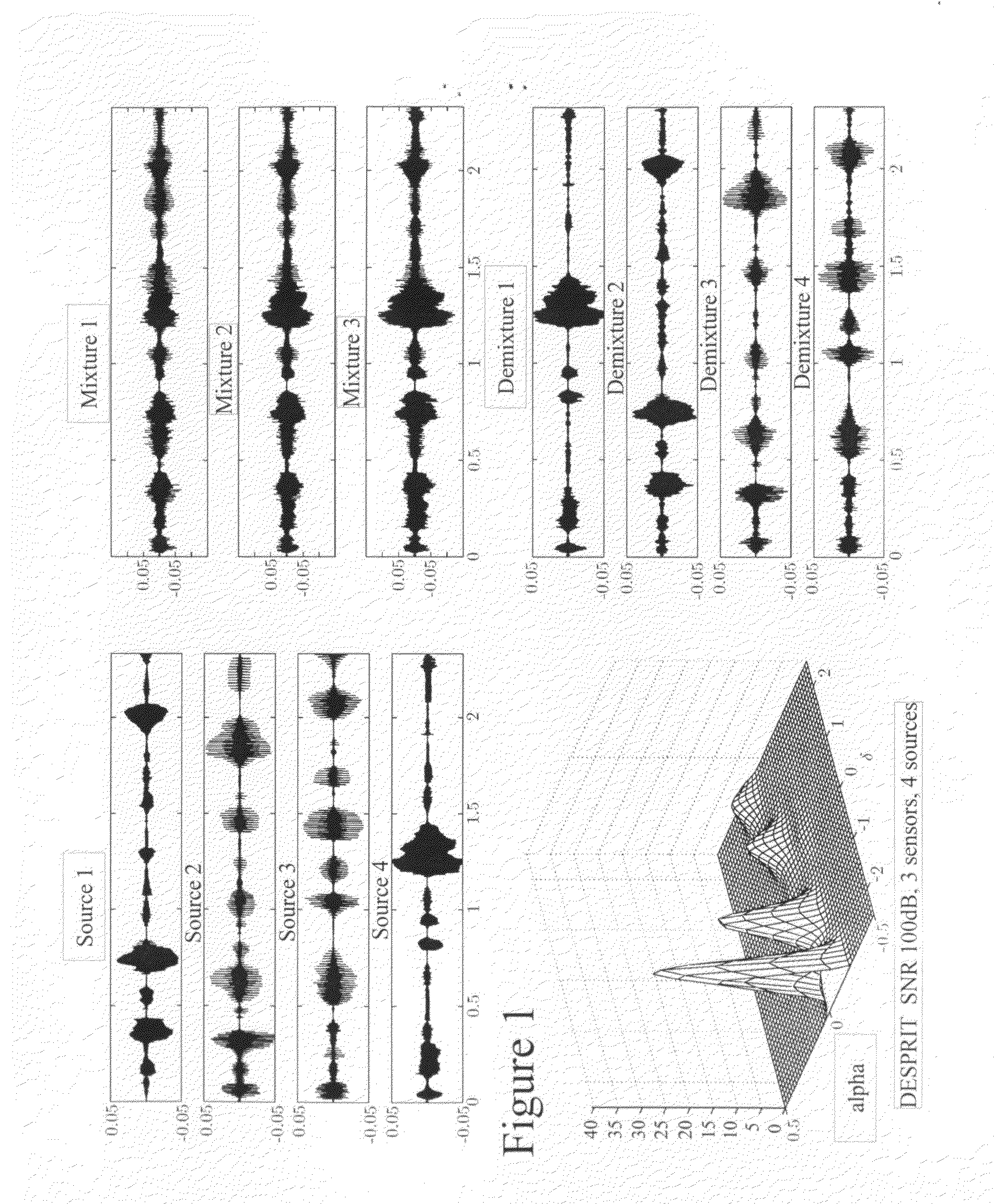Method and apparatus for blind source separation
a technology for separating methods and sources, applied in the field of methods and equipment for separating blind sources, can solve problems such as difficulty in combining results across frequencies
- Summary
- Abstract
- Description
- Claims
- Application Information
AI Technical Summary
Benefits of technology
Problems solved by technology
Method used
Image
Examples
first embodiment
[0051]In the first embodiment, where the invention operates under a strong WDO assumption Λ is a 1-by-1 scalar λ, Σ has all near zero entries and
[Ex(ω,τ)Ey(ω,τ)]
is a 2 m-by-1 vector so as a result the scalar φ is given by
φ=EX(ω,τ)†EX(ω,τ)†
[0052]Furthermore when the expectation operator of equation (10) is approximated by an instantaneous estimate, i.e.
Rzz(ω,τ)=[XW(ω,τ)YW(ω,τ)][XW(ω,τ)HYW(ω,τ)H]
the expression (11) is equivalent to
φ=XW(ω,τ)†YW(ω,τ)
and so in this case the subspace decomposition of the spatial covariance matrix is unnecessary. In the M=2 case this implementation reduces to conventional DUET. Thus, the present invention applies to multichannel (M>2) implementations of this embodiment.
[0053]The steps involved in the multichannel implementation of the first embodiment are as follows:
Step 1
[0054]A uniformly spaced linear array of M sensors receives M anechoic mixtures x1(t), x2(t), . . . , xM(t), of N WDO source signals. These M signals are represented in the 2(M−1)-by-1 t...
second embodiment
[0060]the invention is based on a weak-WDO assumption that allows for more than one source to have significant energy in the same time-frequency coefficient.
[0061]In this embodiment, ESPRIT direction of arrival (as well as attenuation) estimation is performed at each time-frequency point by considering a group of neighbouring time frames for a given frequency. As in DUET, the estimated mixing parameters are used to create a two-dimensional weighted histogram. The weights for the histogram are obtained from the energy of the time-frequency localized demixtures found by applying a demixing matrix based on the mixing parameters estimates for that time-frequency point.
[0062]From the histogram, N peaks are located corresponding to the N source mixing parameter pairs. Demixing is performed by matrix inversion at each time-frequency point, assigning the resulting demixtures based on the distance to the known source mixing parameters.
[0063]In more detail:
Step 1
[0064]A uniform linear array o...
PUM
 Login to View More
Login to View More Abstract
Description
Claims
Application Information
 Login to View More
Login to View More - R&D
- Intellectual Property
- Life Sciences
- Materials
- Tech Scout
- Unparalleled Data Quality
- Higher Quality Content
- 60% Fewer Hallucinations
Browse by: Latest US Patents, China's latest patents, Technical Efficacy Thesaurus, Application Domain, Technology Topic, Popular Technical Reports.
© 2025 PatSnap. All rights reserved.Legal|Privacy policy|Modern Slavery Act Transparency Statement|Sitemap|About US| Contact US: help@patsnap.com



